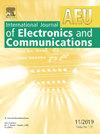A parallelized SIW microwave cavity resonator for compact high-Q low phase noise VCOs in 5G and GNSS applications
IF 3.2
3区 计算机科学
Q2 ENGINEERING, ELECTRICAL & ELECTRONIC
Aeu-International Journal of Electronics and Communications
Pub Date : 2025-09-02
DOI:10.1016/j.aeue.2025.156019
引用次数: 0
Abstract
This paper presents a novel method to enhance the quality factor of a simple square resonator designed using Substrate Integrated Waveguide (SIW) technology, while maintaining cost-efficiency and compactness. Our approach leverages parallelized microwave cavities suitable for high-frequency, low phase noise Voltage-Controlled Oscillators (VCOs) used in fifth generation (5G) and Global Navigation Satellite System (GNSS) applications. Modern communication and navigation systems demand precise frequency and timing systems featuring low phase noise performance, compact size, and cost-efficiency. To reduce the need for high manufacturing precision, we incorporated tuning capability into our microwave resonator without compromising performance characteristics. The proposed resonator achieves a competitive loaded quality factor of approximately 150 at 6.8 GHz, with an insertion loss of about 5.5 dB. Its occupied area is about , which is an appealing feature for high-frequency applications. Our method enables improved quality factor through increasing the number of resonating microwave layers within the same occupied area. The central resonance frequency can be adjusted via a DC-biasing circuit that controls a varactor capacitor, providing a tuning range of 250 MHz.
一种用于5G和GNSS应用中的小型高q低相位噪声压控振荡器的并行SIW微波腔谐振器
本文提出了一种利用衬底集成波导(SIW)技术设计的简单方形谐振器,在保持成本效益和紧凑性的同时,提高其质量因子的新方法。我们的方法利用了适用于第五代(5G)和全球导航卫星系统(GNSS)应用中使用的高频、低相位噪声压控振荡器(vco)的并行微波腔。现代通信和导航系统需要精确的频率和定时系统,具有低相位噪声性能,紧凑的尺寸和成本效益。为了降低对高制造精度的需求,我们在不影响性能特性的情况下将调谐功能集成到微波谐振器中。所提出的谐振器在6.8 GHz时实现了约150的竞争性负载质量因子,插入损耗约为5.5 dB。它的占用面积约为0.4×0.4(λ0×λ0),这对于高频应用来说是一个吸引人的特性。我们的方法通过增加相同占用区域内的谐振微波层数来提高质量因子。中心谐振频率可以通过控制变容电容的直流偏置电路进行调节,提供250 MHz的调谐范围。
本文章由计算机程序翻译,如有差异,请以英文原文为准。
求助全文
约1分钟内获得全文
求助全文
来源期刊
CiteScore
6.90
自引率
18.80%
发文量
292
审稿时长
4.9 months
期刊介绍:
AEÜ is an international scientific journal which publishes both original works and invited tutorials. The journal''s scope covers all aspects of theory and design of circuits, systems and devices for electronics, signal processing, and communication, including:
signal and system theory, digital signal processing
network theory and circuit design
information theory, communication theory and techniques, modulation, source and channel coding
switching theory and techniques, communication protocols
optical communications
microwave theory and techniques, radar, sonar
antennas, wave propagation
AEÜ publishes full papers and letters with very short turn around time but a high standard review process. Review cycles are typically finished within twelve weeks by application of modern electronic communication facilities.

 求助内容:
求助内容: 应助结果提醒方式:
应助结果提醒方式:


